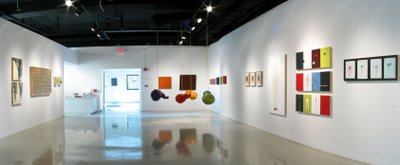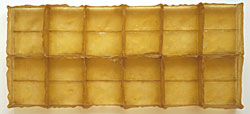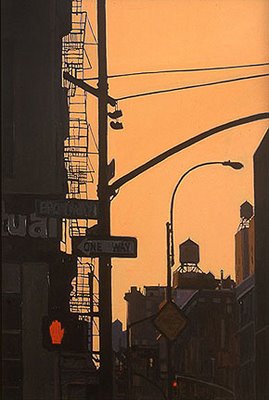Two panoramas from the "Luminous Depths" show. Above, looking into the gallery, from left: Sylvia Netzer (suspended sculptures), Rachel Friedberg, me (Mudra on back wall), Diana Gonzalez Gandolfi; Megan Klim
I'm in a group show at the Ben Shahn Galleries of William Paterson University in Wayne, New Jersey, about 20 miles outside of Manhattan. Curated by gallery director Nancy Einreinhofer, it’s called "Luminous Depths: Six Women Explore the Ancient Art of Encaustic Painting." The six of us are Rachel Friedberg, Diana Gonzalez Gandolfi, Gail Gregg, Megan Klim, Sylvia Netzer and myself. The thematic element here is light. Encaustic—pigmented wax—is particularly suited to luminosity given that wax is almost ethereally translucent, and as light passes through the layers of paint and is reflected up through the surface, an encaustic painting is essentially illuminated from within. Each of us explores that luminosity in a different way, though abstraction is another unifying element.
Below, looking toward the entry, from left: Megan Klim, Gail Gregg, Sylvia Netzer, Rachel Friedberg
 Apropos of the exhibition’s title, someone at the opening asked if women comprised a majority of artists working in the medium. I don’t think so. This show happened to be six women, but from my experience writing The Art of Encaustic Painting, I’d say that wax is less about gender than it is about sensuality and process. If those things turn you on, you're drawn to the medium, whoever you are. Sylvia Netzer is the sculptor in the group. Her fired clay forms, gourdlike in shape, are cloaked in bright wax. They are suspended from yellow rope to within a few feet from the floor, yet they seem to hover, belying the weight and substance of their materials.
Apropos of the exhibition’s title, someone at the opening asked if women comprised a majority of artists working in the medium. I don’t think so. This show happened to be six women, but from my experience writing The Art of Encaustic Painting, I’d say that wax is less about gender than it is about sensuality and process. If those things turn you on, you're drawn to the medium, whoever you are. Sylvia Netzer is the sculptor in the group. Her fired clay forms, gourdlike in shape, are cloaked in bright wax. They are suspended from yellow rope to within a few feet from the floor, yet they seem to hover, belying the weight and substance of their materials.

Sylvia Netzer's wax-covered clay forms, foreground, from The Baby Barry Family; Gail Gregg's paintings and relief sculptures, including Reisling, second from right, and One Way, right
Gail Gregg's forms emerge slightly from the wall, satisfyingly mysterious. Closer inspection reveals that the forms, symmetrical, geometric and topographical, are in fact carton separators laid flat or fast food containers given a healthy new life as art.
Rachel Friedberg's work is figurative in the most reductively abstract way. There are bowties, neckties, trousers and spats along with full-body forms that suggest Cycladic figures or even mummies. The imagery might be a comment on maleness, or the role of males in society, but those reductive forms suggest something about transitional states.
 Rachel Friedberg's paintings and work on paper
Rachel Friedberg's paintings and work on paper
Diana Gonzalez Gandolfi combines geometric abstraction with softer organic shapes. Four paintings, almost twice as long as wide--like windows--open a metaphorical window into her personal iconography.

Four paintings by Diana Gonzalez Gandolfi, including From March to March, second from left, and Hidden Truths, second from right
Layered and netlike, Megan Klim's work was new to me. The paintings were different from one another--one grid based, two landscape like, two biological forms with an erotic charge. Klim seems to be feeling her way through the medium. It's a welcome reminder that wax is a process-intensive medium, and that we are all in some way indebted to the process.

Megan Klim's paintings, back wall on the right
I showed a grid installation of 21 small paintings from my Mudra series, as well as a diptych of larger proportions. Nancy Einreinhofer writes in the catalog: "The build-up of drops of wax signifies the passing of time, a real passing as well as a metaphorical one. The poetry of time passing is seen in the light captured in the layers of wax, seemingly frozen in the medium like a seed in amber." You can see more from my Mudra series on my website.

Joanne Mattera: Big Mudra, left; installation grid of Mudra
After the opening, Nylvia Netzer, Christopher Knowles and I entered the newly dark evening. We'd turned the clocks back the night before, and by 5:00 all daylight was gone. But the moon, a perfect half slice, lit up the sky. "It's a waxing moon," said Christopher. A perfect complement to the show.
"Luminous Depths" is up through December 1. The Ben Shahn Galleries are open Monday through Friday, 10:00 a.m. to 5:00 p.m. Here’s the link for directions: http://ww2.wpunj.edu/aboutus/directions.cfm (click onto the campus map, and you’ll see that the Ben Shahn Center is building #9).
There is a catalog.
Post-exhibition addendum: Paintings from my Mudra series are now at Simon Gallery in Morristown, NJ.

Mudra 24, 12 x 12 inches, encaustic on panel, 2004
 Installation of Eva Hesse: Sculpture at the Jewish Museum, New York City, May 12-September 17, 2006
Installation of Eva Hesse: Sculpture at the Jewish Museum, New York City, May 12-September 17, 2006 Eva Hesse: Repetition Nineteen III, cast resin, 1968
Eva Hesse: Repetition Nineteen III, cast resin, 1968



 Eva Hesse: Contingent, 1969
Eva Hesse: Contingent, 1969

 While the work has aged, Hesse has not. She will always be pictured as a round-faced woman in her early 30s. The exhibition includes black-and-white--and voiceless--Super-8 footage from that time showing her working in her studio. Hesse never lived long enough to grow old. Born in 1936 in Hamburg, she died of a brain tumor in New York in 1970 at the age of 34. (It comes as of a shock to realize she would have been 70 this year.)
While the work has aged, Hesse has not. She will always be pictured as a round-faced woman in her early 30s. The exhibition includes black-and-white--and voiceless--Super-8 footage from that time showing her working in her studio. Hesse never lived long enough to grow old. Born in 1936 in Hamburg, she died of a brain tumor in New York in 1970 at the age of 34. (It comes as of a shock to realize she would have been 70 this year.)













































